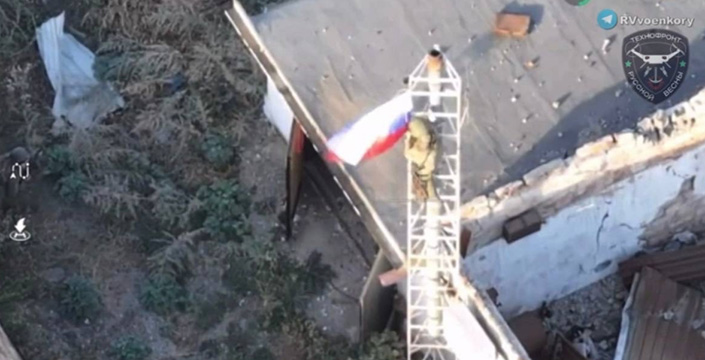 Russian flag over Vuhledar.
Russian flag over Vuhledar.
Photo from a drone
Russian troops entered a Ukrainian outpost on the Eastern front line as Kremlin forces ground their way forward in an offensive that authorities in Kyiv have struggled to stem, Bloomberg informs.
As Russia seeks to cement his control over Ukraine’s eastern Donetsk region, fighting took place within Vuhledar, a strategically located coal-mining town that Ukrainian forces have held.
Russian forces gain ground. After seizing the city of Avdiivka in Donetsk in February, Kremlin troops have gradually built on the advance, threatening strategic towns such as Pokrovsk, more than 600 kilometers (380 miles) southeast of Kyiv.
While Russian military bloggers have posted that Kremlin troops entered the town.
The advance marks a contrast with Ukraine’s surprise cross-border incursion into the western Russian region of Kursk, an operation that many allies viewed as a way to draw Kremlin troops away from the eastern front. Still, Russian forces have continued to make slow if steady progress in the east.
If Russian forces eventually seize Pokrovsk, as they probably will in the end, the landscape to the west is flatter and so more favourable to further Russian advances, writes ‘The Economist’.
What is more, Russia still enjoys a huge advantage in firepower, even after Ukraine received a big influx of American weapons earlier this year. Russian artillery rules the front line, firing as many as ten shells for every Ukrainian one in some places. Russia also gets an edge from its glide bombs, guided munitions of 500kg, 1,500kg or 3,000kg that can flatten defensive positions and slaughter troops.
And whereas most of the Russian troops have signed up voluntarily, Ukraine is relying ever more on conscription. Officers complain that many of those drafted into service are ill-suited to fighting: too old, too ill, too drunk. There is no clear path out of the army once in it, which makes being mobilised seem like a one-way ticket to the morgue.
Some 5-10% of soldiers on active duty are absent without leave. The authorities are prosecuting lots of deserters, but they do not command as much fear as Mr Putin’s regime. Fewer than 30% of Ukrainians consider draft-dodging shameful, according to an opinion poll.
These problems have been exacerbated to some extent by Ukraine’s incursion into the Russian province of Kursk, which began in August. Although this offensive reaffirmed Ukraine’s capacity to seize the initiative, outsmart Russian forces and embarrass Mr Putin, it also extended the front lines and stretched Ukraine’s supply-lines. It has not prompted Russia to slow its offensive in Donetsk, as hoped, although some Russian forces have been diverted to Kursk’s defence. And it has reduced the resources available for the defence of Pokrovsk:
The main problem, however, is cash. Ukraine’s government does not have the money to buy local arms manufacturers’ output. Order books are less than half full in some cases. Ukraine could produce more than 3m short-range attack drones a year, for instance, but the army has only been able to contract for 1.5m of them.
But Russia, too, is making more weapons. Mr Putin has pledged to increase the production of drones by a factor of almost ten this year. The manufacture of glide bombs and Iskander missiles has surged sevenfold since late 2022.
Among other things, these weapons have allowed Russia to launch nine waves of attacks from March to August against Ukraine’s power plants and electricity grid. It has hit targets in almost every province under Ukrainian control, according to a recent un report. This onslaught took out some 80% of Ukraine’s coal- and gas-fired generation.
Life can seem deceptively normal in big cities like Odessa, where open-air restaurants are packed, spinning classes sell out and people taking selfies obstruct the seaside promenade. But 77% of Ukrainians say a friend or acquaintance has died in the war; 22% have lost a relative. Expectations of how long the war will last are increasing.
The government is even harder up. Its revenues are barely projected to cover half of its spending in 2025. It needs grants or loans to cover the remaining $38bn or so. Although allies including America and the eu have agreed to fund the deficit using earnings from frozen Russian assets, the process is bureaucratic and leaves Ukraine hostage to its benefactors’ whims.
“The West and the United States in particular have an unequivocal responsibility for the deaths of Ukrainians,” says Yuriy Fedorenko, who commands a drone unit. “The West, with its helpless and impotent reaction, gives silent consent to this destruction.”
Perhaps inevitably, Ukrainians’ trust in Mr Zelensky has fallen, from 80% in May 2023 to 45% this year, according to America’s National Democratic Institute. Trust in the government in general is much lower still.
read more in our Telegram-channel https://t.me/The_International_Affairs

 10:12 04.10.2024 •
10:12 04.10.2024 •






















